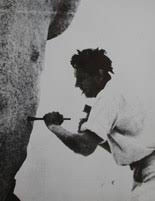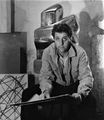P gallery
sculpture








EMILE GILIOLI, 1911-1977
Emile Gilioli was born in Paris in 1911, but grew up with his grandparents in Italy. From an early age he learned valuable skills as a craftsman working at the local blacksmith. In 1928 he joined his father in Nice, where he worked for the sculptor Giavacci, while attending evening classes at the Ecole des Arts Décoratifs. In 1931 he was admitted to the Ecole des Beaux-Art in Paris, where he studied with Jean Boucher. In 1940 he moved to Grenoble. Here he befriended Andry-Fracy, the curator of the Grenoble Musée des Beaux-Arts, and Henri Closon, a pioneer of French abstraction. His first solo exhibition took place in 1941 at the Galerie Lafarge.
After the war, Gilioli initially settled in Saint-Martin-de-la-Cluze, a village near Grenoble, where he would continue to spend time on and off throughout his life. In 1997 his house/workshop there was acquired by the municipality and eventually turned into a museum dedicated to the sculptor. Gilioli carried out several war memorials in the Isère region, such as the Memorial of Voreppe (1946), the war memorial for the deportees of Grenoble (1950), and the National Monument of the Resistance at Les Glières, Haute Savoie (1973).
Inspired by Pre-Colombian, Coptic, and archaic Greek sculpture as well as Cubism, Gilioli slowly embraced and helped to formulate the dominant artistic trend of his times. From 1946 onwards he all but abandoned figuration in favor of abstraction. Taking an active part in the avant-garde Parisian art scene, he befriended many other artists, such as the abstract painters Serge Poliakoff and Victor Vasarely and the sculptor Constantin Brancusi. Gilioli participated in the first Salon de la Jeune Sculpture in 1949 and was elected vice-president of the group Espace in 1951, led by artists such as André Bloc, Fernand Léger and Corbusier. Espace aimed at bringing about a synthesis between painting, sculpture and architecture. The group dissolved five years later, but Gilioli remained faithful to the idea of the integration of architecture and sculpture. He believed there was no essential difference between the two and loved making sculptures that were ‘at the same time houses’. Starting from a core, Gilioli would painstakingly ‘build’ his sculpture until the exact right tautness was reached. Hence he described himself as both a ‘constructer’ and a ‘demolisher’. Gilioli worked in many materials. Feeling that a sculpture should ‘resemble the sky’ his bronze sculptures are polished with a mirror finish as can be appreciated in the pictures above.
From the end of the forties onward Gilioli embarked on an incredibly successful and dynamic career with group and solo exhibitions in prestigious galleries (such as the galerie Louis Carre,) and museums (e.g. Palais Galliera, 1968) all over the world. He received various awards and distinctions, such as the Grand Prix de Sculpture of Carrare (1959) and the Grand Prix de la ville de Paris (1974).
Emilio Gilioli died in 1977. Two years later, in 1979, he had a retrospective exhibition in the Centre George Pompidou.
Gilioli’s work is included in the collections of major museums, such as the Centre de Pompidou, the Museum of Modern Art in Paris, Tate Gallery and MoMA.
Emile Gilioli est né à Paris en 1911, mais a grandi avec ses grands-parents en Italie. Dès son plus jeune âge, il acquiert de précieuses compétences en tant qu’artisan travaillant chez un forgeron local. En 1928, il rejoint son père à Nice, où il travaille pour le sculpteur Giavacci, tout en suivant des cours du soir à l’École des Arts Décoratifs. En 1931, il est admis à l’Ecole des Beaux-Arts de Paris, où il étudie avec Jean Boucher. En 1940, il s’installe à Grenoble. Il s’y lie d’amitié avec Andry-Fracy, conservateur du musée des Beaux-Arts de Grenoble, et Henri Closon, artiste pionnier de l’abstraction française. Sa première exposition personnelle a lieu en 1941 à la Galerie Lafarge.
Après la guerre, Gilioli s’est d’abord installé à Saint-Martin-de-la-Cluze, un village près de Grenoble, où il a continué à se rendre et à passer du temps tout au long de sa vie. En 1997, sa maison-atelier est rachetée par la municipalité et devient un musée dédié au sculpteur. Gilioli a réalisé plusieurs monuments aux morts en Isère, tels que le monument aux martyrs du Vercors à Vassieux (1944), l’Homme de douleur à Voreppe (1946), le monument des Déportés de l’Isère à Grenoble (1950), et le monument national à la Résistance aux Glières en Haute-Savoie (1973).
Inspiré par l’ère précolombienne, le coptisme, la sculpture grecque archaïque et le cubisme, Gilioli a joué un rôle de novateur dans la scène artistique de son époque. À partir de 1946, il abandonne la figuration au profit de l’abstraction. Membre actif de la scène artistique parisienne d’avant-garde, il se lie d’amitié avec de nombreux artistes, dont les peintres abstraits Serge Poliakoff et Victor Vasarely, ainsi que le sculpteur Constantin Brancusi. Gilioli participe au premier Salon de la Jeune Sculpture en 1949 et est élu vice-président du groupe « Espace » en 1951, dirigé par des artistes tels qu’André Bloc, Fernand Léger et Le Corbusier. L’« Espace » visait à établir un lien entre la peinture, la sculpture et l’architecture. Le groupe se dissout cinq ans plus tard, mais Gilioli croit toujours à la liaison étroite entre l’architecture et la sculpture. Selon lui, il n’y a pas de différence essentielle entre les deux arts et se met à réaliser des sculptures qui sont « en même temps des maisons ». À partir d’un noyau, Gilioli « construit » méticuleusement la sculpture jusqu’à ce qu’il atteigne la limite exacte de l’intensité. Il se décrivait ainsi à la fois comme un « constructeur » et un « démolisseur ». Émile Gilioli travaillait de nombreux matériaux. Estimant qu’une sculpture doit « ressembler au ciel », ses sculptures en bronze sont polies avec une finition miroir, comme on peut le voir sur les images ci-dessus.
À la fin des années 1940, Gilioli a entamé une carrière incroyablement réussie et dynamique, avec des expositions collectives et individuelles dans des galeries prestigieuses (comme la galerie Louis Carré) et des musées (comme le Palais Galliera, en 1968). Il a reçu de nombreux prix et distinction, dont le Grand Prix de Sculpture de Carrare en Italie (1959) et le Grand Prix de la ville de Paris (1974).
Emilio Gilioli est décédé en 1977. Deux ans plus tard, une exposition rétrospective et honorifique de quarante œuvres de ses trente ans de carrière, 1946-1976, est organisée au Centre Georges Pompidou.
Ses œuvres font partie des collections de grands musées tels que le Centre Georges Pompidou, le Musée d’art moderne de Paris, la Tate Gallery de Londres et le MoMA de New York.
Ο Émile Gilioli γεννήθηκε στο Παρίσι το 1911, αλλά μεγάλωσε με τους παππούδες του στην Ιταλία. Από νεαρή ηλικία έμαθε τις δεξιότητες ενός επαγγελματία σιδερά καθώς εργάστηκε σε τοπικό σιδηρουργείο. Το 1928 πήγε να ζήσει με τον πατέρα του στη Νίκαια, όπου εργάστηκε για τον γλύπτη Giavacci, ενώ παράλληλα παρακολουθούσε απογευματινά μαθήματα στην École des Arts Décoratifs. Το 1931 έγινε δεκτός στην École des Beaux-Art στο Παρίσι όπου σπούδασε με τον Jean Boucher. Το 1940 μετακόμισε στην Γκρενόμπλ. Εκεί, συνδέθηκε φιλικά με τον Andry-Fracy, επιμελητή στο Μουσείο Καλών Τεχνών της Γκρενόμπλ, και με τον Henri Closon, πρωτοπόρο καλλιτέχνη της γαλλικής αφαίρεσης. Η πρώτη του ατομική έκθεση πραγματοποιήθηκε το 1941 στην Galerie Lafarge.
Μετά τον πόλεμο, o Gilioli εγκαταστάθηκε αρχικά στο Saint-Martin-de-la-Cluze, ένα χωριό κοντά στην Γκρενόμπλ, όπου και συνέχισε να επισκέπτεται και να περνά χρόνο καθόλη τη διάρκεια της ζωής του. Το 1997 το σπίτι/εργαστήρι του περιήλθε στην ιδιοκτησία του δήμου που τελικά το μετέτρεψε σε μουσείο αφιερωμένο στον γλύπτη. Ο Gilioli πραγματοποίησε αρκετά πολεμικά μνημεία στην περιοχή Isère, όπως το μνημείο του Voreppe (1946), το Mνημείο των απελαθέντων από την Γκρενόμπλ σε στρατόπεδα συγκέντρωσης (1950) και το Εθνικό Μνημείο της Αντίστασης στο Les Glières, Haute Savoie (1973).
Εμπνευσμένος από την προκολομβιανή εποχή, την κοπτική, την αρχαϊκή ελληνική γλυπτική καθώς και από τον κυβισμό, ο Gilioli συνέβαλε στη διαμόρφωση της κυρίαρχης καλλιτεχνικής τάσης της εποχής του. Από το 1946 και μετά εγκατέλειψε την παραστατικότητα και στράφηκε ολοκληρωτικά στην αφαίρεση. Λαμβάνοντας ενεργό μέρος στην avant-garde καλλιτεχνική σκηνή του Παρισιού, συνδέθηκε φιλικά με πολλούς καλλιτέχνες, όπως τους ζωγράφους Serge Poliakoff και Victor Vasarely, και τον γλύπτη Constantin Brancusi. Ο Gilioli συμμετείχε στο πρώτο Salon de la Jeune Sculpture το 1949 και εξελέγη αντιπρόεδρος της ομάδας «Espace» το 1951, της οποίας ηγούνταν καλλιτέχνες όπως ο André Bloc, ο Fernand Léger και ο Le Corbusier. Η «Espace» είχε ως στόχο την επίτευξη μιας σύνδεσης μεταξύ ζωγραφικής, γλυπτικής και αρχιτεκτονικής. Η ομάδα διαλύθηκε πέντε χρόνια αργότερα, όμως ο Gilioli παρέμεινε πιστός στην ιδέα της ενοποίησης της αρχιτεκτονικής με τη γλυπτική. Ο ίδιος πίστευε ότι δεν υπάρχει ουσιαστική διαφορά μεταξύ των δύο τεχνών και αγαπούσε να φτιάχνει γλυπτά που ήταν « την ίδια στιγμή και σπίτια ». Ξεκινώντας από έναν πυρήνα, ο Gilioli «οικοδομούσε» με επιμέλεια το γλυπτό μέχρι να φτάσει στο ακριβές όριο της έντασης. Ως εκ τούτου, ο ίδιος περιγράφει τον εαυτό του ως «κατασκευαστή» και ταυτόχρονα ως «κατεδαφιστή». Ο Émile Gilioli εργάστηκε με πολλά υλικά. Θεωρώντας ότι ένα γλυπτό πρέπει να «μοιάζει με τον ουρανό», γυάλιζε τα χάλκινα γλυπτά του με φινίρισμα καθρέφτη, (βλ. τις παραπάνω φωτογραφίες).
Στα τέλη της δεκαετίας του 1940, ο Gilioli ξεκίνησε μια απίστευτα επιτυχημένη και δυναμική διεθνή καριέρα, με ομαδικές και ατομικές εκθέσεις σε σημαντικές γκαλερί (όπως η Galerie Louis Carré, 1958) και μουσεία (όπως το Palais Galliera, 1968). Έλαβε πολλά βραβεία και διακρίσεις, όπως το Grand Prix de Sculpture της Carrare στην Ιταλία (1959) και το Grand Prix de la Ville de Paris (1974).
Ο Émilie Gilioli απεβίωσε το 1977. Δύο χρόνια αργότερα, πραγματοποιήθηκε αναδρομική, τιμητική έκθεση με σαράντα έργα της τριαντάχρονης πορείας του, 1946-1976, στο Κέντρο Georges Pompidou.
Έργα του περιλαμβάνονται σε συλλογές μεγάλων μουσείων όπως το Κέντρο Georges Pompidou, το Μουσείο Μοντέρνας Τέχνης στο Παρίσι, η Tate Gallery στο Λονδίνο και το MoMA στη Νέα Υόρκη.





